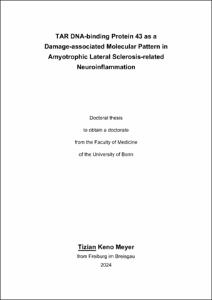TAR DNA-binding Protein 43 as a Damage-associated Molecular Pattern in Amyotrophic Lateral Sclerosis-related Neuroinflammation

TAR DNA-binding Protein 43 as a Damage-associated Molecular Pattern in Amyotrophic Lateral Sclerosis-related Neuroinflammation

| dc.contributor.advisor | Weydt, Patrick | |
| dc.contributor.author | Meyer, Tizian Keno | |
| dc.date.accessioned | 2024-01-10T12:14:26Z | |
| dc.date.available | 2024-01-10T12:14:26Z | |
| dc.date.issued | 10.01.2024 | |
| dc.identifier.uri | https://hdl.handle.net/20.500.11811/11232 | |
| dc.description.abstract | ALS as one of the most common and aggressive neuromuscular diseases is characterized by rapidly progressing and, in later stages, generalized muscular decline. As of today, limited therapeutic options exist and there is no significant disease modifying therapy. Pathological hallmarks are mislocalized, insoluble cytoplasmic protein aggregates positive for TDP-43 that are prevalent mainly in motor neurons. While disease etiology is complex and remains an enduring enigma, neuroinflammation is emerging as a key player in recent years. Drivers of this process are predominantly microglia, which represent the first line of defense within the CNS. In a self-amplifying manner, their overactivation can account for non-cell autonomous toxicity and exacerbates disease progression. A profound knowledge of underlying mechanisms is therefore of eminent importance. In this study, I was able to examine in detail the stimulatory potential of TDP-43 protein species as one of the hallmarks in ALS pathology. I report for the first time of the differential effects of monomeric and fibrillary isoforms in both macrophage cell lines and primary microglia and exemplify results using human tissue. Upon stimulation with monomeric TDP-43, the NLRP3 inflammasome, a key regulator of inflammation, is activated and a broad variety of immune mediators are upregulated. These include TNF-α and IL-6 as two prototypical proinflammatory mediators. In addition, the existing knowledge is expanded to the effect that Toll-like receptors are involved in sensing TDP-43 molecules and initiate an intracellular signaling cascade which leads to NLRP3 inflammasome priming and activation provoking early apoptosis. Taken together, the results underline that TDP-43 as an important ALS-associated protein species is a crucial player in ALS pathology, namely the neuroinflammatory process. The data provide evidence that monomeric TDP-43 in its wild-type full-length form can drive neuroinflammation. | en |
| dc.language.iso | eng | |
| dc.rights | In Copyright | |
| dc.rights.uri | http://rightsstatements.org/vocab/InC/1.0/ | |
| dc.subject | ALS | |
| dc.subject | TDP-43 | |
| dc.subject | Neuroinflammation | |
| dc.subject | NLRP3-Inflammasom | |
| dc.subject | Mikroglia | |
| dc.subject.ddc | 610 Medizin, Gesundheit | |
| dc.title | TAR DNA-binding Protein 43 as a Damage-associated Molecular Pattern in Amyotrophic Lateral Sclerosis-related Neuroinflammation | |
| dc.type | Dissertation oder Habilitation | |
| dc.identifier.doi | https://doi.org/10.48565/bonndoc-197 | |
| dc.publisher.name | Universitäts- und Landesbibliothek Bonn | |
| dc.publisher.location | Bonn | |
| dc.rights.accessRights | openAccess | |
| dc.identifier.urn | https://nbn-resolving.org/urn:nbn:de:hbz:5-73893 | |
| ulbbn.pubtype | Erstveröffentlichung | |
| ulbbnediss.affiliation.name | Rheinische Friedrich-Wilhelms-Universität Bonn | |
| ulbbnediss.affiliation.location | Bonn | |
| ulbbnediss.thesis.level | Dissertation | |
| ulbbnediss.dissID | 7389 | |
| ulbbnediss.date.accepted | 19.12.2023 | |
| ulbbnediss.institute | Medizinische Fakultät / Kliniken : Klinik für Neurodegenerative Erkrankungen & Gerontopsychiatrie | |
| ulbbnediss.fakultaet | Medizinische Fakultät | |
| dc.contributor.coReferee | Geyer, Matthias |
Dateien zu dieser Ressource
Das Dokument erscheint in:
-
E-Dissertationen (2059)




